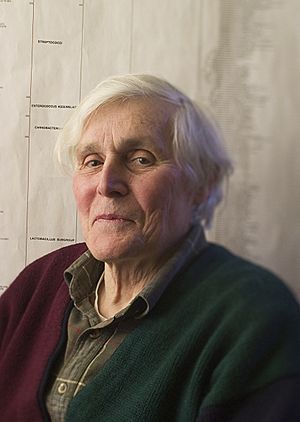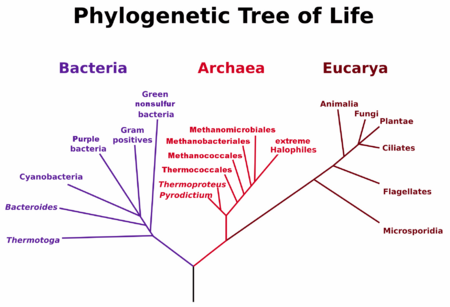Carl Woese facts for kids
Quick facts for kids
Carl Woese
|
|
|---|---|

Woese in 2004
|
|
| Born | July 15, 1928 Syracuse, New York, U.S.
|
| Died | December 30, 2012 (aged 84) Urbana, Illinois, U.S.
|
| Citizenship | United States |
| Alma mater |
|
| Known for | Discovery of Archaea |
| Awards |
|
| Scientific career | |
| Fields | Microbiology |
| Institutions | University of Illinois at Urbana–Champaign |
| Thesis | Physical Studies on Animal viruses (1953) |
| Doctoral advisor | Ernest C. Pollard |
| Notable students | David Stahl |
Carl Richard Woese (born July 15, 1928 – died December 30, 2012) was an American scientist. He studied microbiology and biophysics. Woese is famous for discovering a new group of life called Archaea in 1977. He did this by studying their 16S ribosomal RNA. This method changed how we understand tiny living things.
Carl Woese also came up with the idea of the RNA world hypothesis in 1967. This idea suggests that early life on Earth used RNA for many important jobs. He was a professor of microbiology at the University of Illinois at Urbana–Champaign.
Contents
About Carl Woese
Early Life and School
Carl Woese was born in Syracuse, New York, on July 15, 1928. He went to Deerfield Academy in Massachusetts. In 1950, he earned a bachelor's degree. He studied mathematics and physics at Amherst College.
While at Amherst, Woese only took one biology class. He wasn't very interested in plants or animals at first. But a physics professor suggested he study biophysics at Yale University.
College and Research
In 1953, he earned his PhD in biophysics from Yale University. His research looked at how heat and radiation affected viruses. He also studied medicine for two years at the University of Rochester.
From 1960 to 1963, Woese worked as a biophysicist. He was at the General Electric Research Laboratory. In 1964, he joined the University of Illinois at Urbana–Champaign. There, he focused on Archaea and how life changes over time. The Carl R. Woese Institute for Genomic Biology was named after him in 2015.
Carl Woese passed away on December 30, 2012. He died from problems related to pancreatic cancer. He left behind his wife, Gabriella, and their two children.
Carl Woese's Discoveries
Understanding the Genetic Code
In the early 1960s, Woese started studying the genetic code. This code is like a secret language. It tells cells how to build proteins. Scientists were trying to figure out how DNA's four "letters" matched up with the twenty amino acids.
Woese published several papers on this topic. He helped figure out how the code works. He also thought about how the genetic code might have changed over time. He wondered how it evolved to create different life forms.
Discovering a New Group of Life
For a long time, scientists thought that all tiny living things without a cell nucleus were just one group. They called them prokaryotes. It was believed that all life came from a single prokaryotic ancestor.
But in 1977, Carl Woese and George E. Fox found something new. They discovered a type of tiny life they called "archaebacteria." They showed that these "archaebacteria" were very different. They were as unique as bacteria, plants, or animals.
Woese renamed them Archaea. He then redrew the tree of life. His new system had three main groups, or "domains": Bacteria, Archaea, and Eucarya. This new tree showed how all life is related.

At first, many scientists didn't accept Woese's ideas. Some famous biologists disagreed with him. But more and more evidence supported his discovery. By the mid-1980s, the scientific world accepted Archaea. Today, few scientists think all prokaryotes are the same.
Woese's work on Archaea is also important for finding life on other planets. Before his discovery, scientists thought Archaea were rare. They believed these "extreme" organisms evolved from more common microbes. Now, most think Archaea are very ancient. They might be similar to the first living things on Earth. This means life like Archaea could exist on other planets. Especially on planets with harsh conditions.
Woese's work showed how diverse tiny organisms are. These single-celled creatures make up most of Earth's living things. They are vital for many natural cycles. His efforts helped us understand how life evolved.
How Early Cells Evolved
Woese also thought about how life changed quickly in the early days of Earth. He suggested that early organisms shared their genes easily. He called these early cells progenotes. They were very simple. Their genetic systems made many mistakes. This meant they had high mutation rates.
This early way of life allowed for fast changes across the entire ecosystem. The "Darwinian Threshold" was when cells became more complex. They developed better ways to copy their genes. This made it harder for genes from other organisms to take over.
Later in his career, Woese studied horizontal gene transfer. This is when organisms share genes with each other. He wanted to understand how the main types of cells (Archaea, Bacteria, and Eukaryotes) came from an early "RNA world."
His View on Biology
Carl Woese believed that biology played a very important role in society.
Awards and Legacy
Carl Woese received many honors for his work:
- He was a MacArthur Fellow in 1984.
- He became a member of the National Academy of Sciences in 1988.
- He received the Leeuwenhoek Medal in 1992. This is microbiology's highest honor.
- He won the Selman A. Waksman Award in Microbiology in 1995.
- He received the National Medal of Science in 2000.
- In 2003, he was awarded the Crafoord Prize. This was for his discovery of the third domain of life.
- He was elected to the American Philosophical Society in 2004.
- In 2006, he became a foreign member of the Royal Society.
Many tiny living things are named after him. These include Pyrococcus woesei and Methanobrevibacter woesei.
Justin Sonnenburg, a microbiologist, said Woese's 1977 paper was one of the most important in biology. He compared it to the work of Watson and Crick on DNA, and even Darwin's ideas on evolution.
Professor Norman R. Pace said that Woese did more for biology than any other biologist in history. He even included Darwin in that statement.
See also
 In Spanish: Carl Woese para niños
In Spanish: Carl Woese para niños
- Archaea
- Bacterial phyla
- George E. Fox
- Karl Stetter
- Norman R. Pace
- Otto Kandler
- Phylogenetics
- Tree of life (biology)
- 16S ribosomal RNA
- Woeseian revolution
- Woese's dogma

